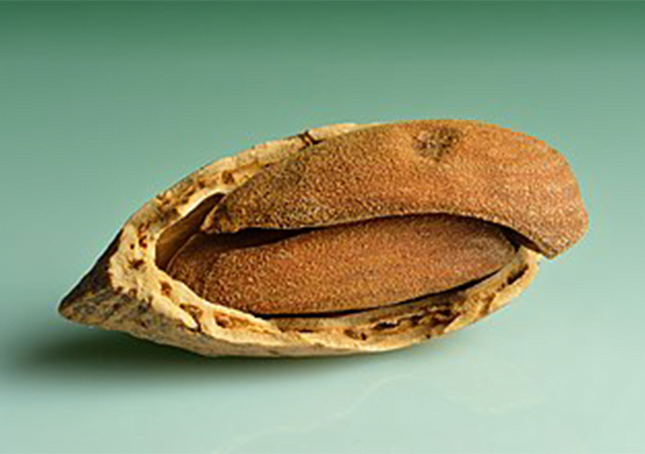Almond

The almond (Prunus dulcis, syn. Prunus amygdalus) is a species of tree native to Iran and surrounding countries[3][4] but widely cultivated elsewhere. The almond is also the name of the edible and widely cultivated seed of this tree.
Within the genus Prunus, it is classified with the peach in the subgenus Amygdalus, distinguished from the other subgenera by corrugations on the shell (endocarp) surrounding the seed.
The fruit of the almond is a drupe, consisting of an outer hull and a hard shell with the seed, which is not a true nut, inside. Shelling almonds refers to removing the shell to reveal the seed. Almonds are sold shelled or unshelled. Blanched almonds are shelled almonds that have been treated with hot water to soften the seedcoat, which is then removed to reveal the white embryo.
The almond is a deciduous tree, growing 4–10 m (13–33 ft) in height, with a trunk of up to 30 cm (12 in) in diameter. The young twigs are green at first, becoming purplish where exposed to sunlight, then grey in their second year. The leaves are 8–13 cm (3–5 in) long,[5] with a serrated margin and a 2.5 cm (1 in) petiole. The flowers are white to pale pink, 3–5 cm (1–2 in) diameter with five petals, produced singly or in pairs and appearing before the leaves in early spring. Almond grows best in Mediterranean climates with warm, dry summers and mild, wet winters.
The optimal temperature for their growth is between 15 and 30 °C (59 and 86 °F) and the tree buds have a chilling requirement of 200 to 700 hours below 7.2 °C (45.0 °F) to break dormancy.
Almonds begin bearing an economic crop in the third year after planting. Trees reach full bearing five to six years after planting. The fruit matures in the autumn, 7–8 months after flowering.
The almond is native to Iran and surrounding countries. It was spread by humans in ancient times along the shores of the Mediterranean into northern Africa and southern Europe, and more recently transported to other parts of the world, notably California, United States.[4] The wild form of domesticated almond grows in parts of the Levant.[12]
Selection of the sweet type from the many bitter types in the wild marked the beginning of almond domestication.[13] It is unclear as to which wild ancestor of the almond created the domesticated species. The species Prunus fenzliana may be the most likely wild ancestor of the almond, in part because it is native to Armenia and western Azerbaijan, where it was apparently domesticated.[14] Wild almond species were grown by early farmers, “at first unintentionally in the garbage heaps, and later intentionally in their orchards”.[15]
Almonds were one of the earliest domesticated fruit trees, due to “the ability of the grower to raise attractive almonds from seed. Thus, in spite of the fact that this plant does not lend itself to propagation from suckers or from cuttings, it could have been domesticated even before the introduction of grafting”.[12] Domesticated almonds appear in the Early Bronze Age (3000–2000 BC), such as the archaeological sites of Numeira (Jordan),[13] or possibly earlier. Another well-known archaeological example of the almond is the fruit found in Tutankhamun’s tomb in Egypt (c. 1325 BC), probably imported from the Levant. An article on Almond tree cultivation in Spain is brought down in Ibn al-‘Awwam’s 12th-century agricultural work, Book on Agriculture.
Of the European countries that the Royal Botanic Garden Edinburgh reported as cultivating almonds, Germany[17] is the northernmost, though the domesticated form can be found as far north as Iceland.
